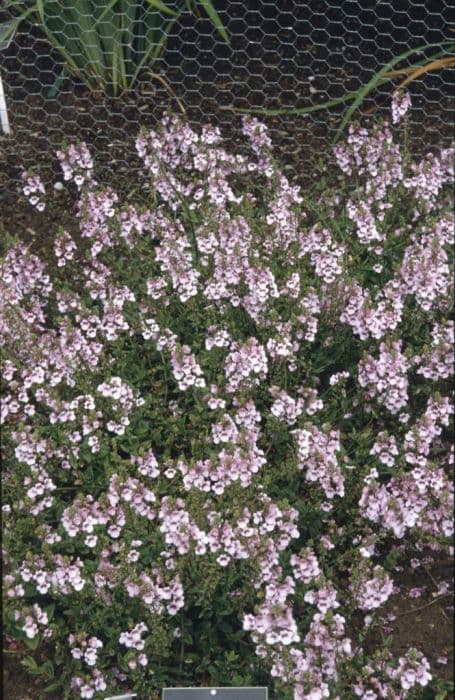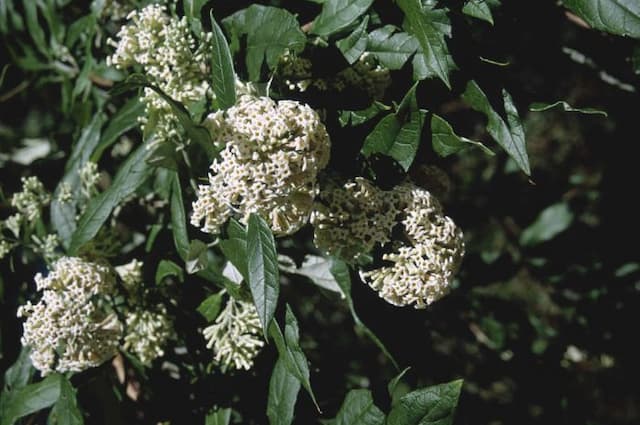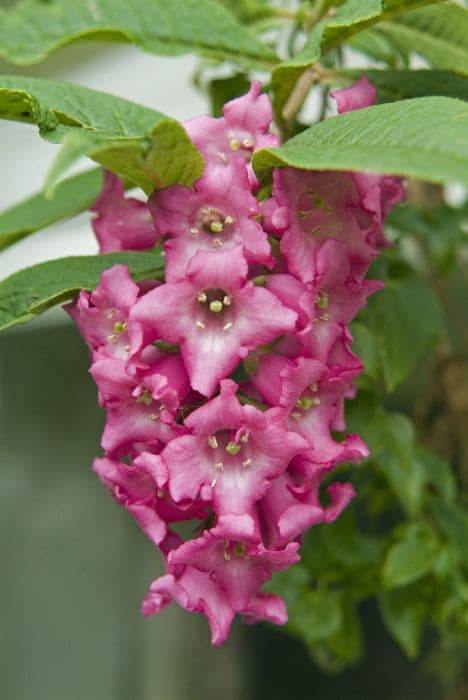Twinspur Diascia 'Lilac Mist'

ABOUT
Diascia 'Lilac Mist', popularly known simply as Twinspur, is a charming flowering plant known for its soft lilac color. The flower of the Twinspur has a unique appearance, characterized by its delicate petals that have a light purple hue, often with subtle variations in shade that create a misty effect. The shape of the petals is akin to small trumpets, which are clustered together in loose, airy sprays that give the plant an ethereal and frothy appearance. The Twinspur foliage presents a lush backdrop to the blooms with its bright green color and slightly glossy texture. The leaves are typically small and narrow, often described as lance-shaped, and they possess a neat, tidy look that complements the profusion of flowers. The overall form of the plant is mounded, creating an impression of softness and fullness that is particularly appealing in garden borders or as a part of a floral arrangement. Throughout its blooming season, the Twinspur provides a continuous display of color, with the blossoms attracting pollinators such as bees and butterflies, adding to the visual interest of any garden or container in which the plant is placed. Its delicate color and form make it a favorite among gardeners seeking to create a peaceful and romantic garden atmosphere.
About this plant
 Names
NamesFamily
Scrophulariaceae
Synonyms
Twinspur
Common names
Diascia 'Lilac Mist'.
 Toxicity
ToxicityTo humans
Diascia 'Lilac Mist', commonly known as Twinspur, is not widely reported to be toxic to humans. Most sources do not indicate any poisonous effects from ingesting or handling this plant. However, as with any plant, individual allergies or sensitivities could occur, and it is generally advisable not to consume plant material that is not confirmed as safe to eat. If an individual were to ingest Twinspur and then experience any unusual symptoms, medical advice should be sought.
To pets
Twinspur is not commonly known to be toxic to pets. There is limited information available on the toxicity of this particular variety of Diascia to animals, but generally, the genus is not listed among those plants that are considered hazardous to pets. However, individual cases may vary, and some pets could exhibit sensitivity or allergic reactions. If a pet ingests Twinspur and shows any signs of distress, it is recommended to consult a veterinarian.
 Characteristics
CharacteristicsLife cycle
Perennials
Foliage type
Semi-deciduous
Color of leaves
Green
Flower color
Lilac
Height
1 foot (30 cm)
Spread
1 foot (30 cm)
Plant type
Herb
Hardiness zones
9
Native area
South Africa
Benefits
 General Benefits
General Benefits- Attracts Pollinators: Diascia 'Lilac Mist', commonly known as Twinspur, is known for attracting bees and butterflies to the garden which aids in pollination.
- Low Maintenance: Twinspur is generally easy to care for and does not require frequent watering or fertilizing, making it a convenient choice for busy gardeners.
- Long Blooming Period: Twinspur provides flowers from spring to fall, offering a prolonged display of its lilac mist colored blooms.
- Drought Tolerant: Once established, Diascia 'Lilac Mist' can tolerate periods of dryness, making it suitable for xeriscaping or drought-prone areas.
- Compact Growth: With its mounding habit, this plant is ideal for small gardens, mixed borders, or container planting, where it won't overpower its neighbors.
- Aesthetic Appeal: The delicate flowers and soft color add charm and a splash of color to garden beds, borders, or hanging baskets.
- Deer Resistant: Generally, Diascia is not preferred by deer, making it a good choice for gardens in areas with deer pressure.
 Medical Properties
Medical PropertiesThis plant is not used for medical purposes.
 Air-purifying Qualities
Air-purifying QualitiesThis plant is not specifically known for air purifying qualities.
 Other Uses
Other Uses- Twin-spur can be used to create a colorful ground cover in a garden, spreading to fill in gaps between other plants and providing a consistent carpet of foliage and flowers.
- The plant can serve as a living mulch, helping to retain soil moisture and suppress weeds due to its dense growth habit.
- In floral art, the delicate flowers of twin-spur can be used to provide a subtle, soft contrast in arrangements or bouquets.
- As a nectar-rich plant, twin-spur can be cultivated to attract and support pollinators like bees and butterflies in a wildlife garden.
- The plant's foliage can be used in pressed flower crafts, providing interesting shapes and textures for decorative pieces.
- Twin-spur can be used in sensory gardens for its tactile and visually engaging flowers, which can be appreciated up close.
- The plant's compact and mounding habit makes it suitable for planting in hanging baskets and window boxes, where it can cascade over the edges.
- When dried, the stems and flowers of twin-spur can be utilized in dried floral displays or potpourri for their form and potential fragrance.
- Twin-spur can act as a seasonal camouflage for fading bulb foliage in spring, as other plants die back and need to be disguised.
- Garden educators might use twin-spur to teach principles of landscaping and garden design, using its growth patterns and color to demonstrate concepts.
Interesting Facts
 Feng Shui
Feng ShuiThe plant Diascia is not used in Feng Shui practice.
 Zodiac Sign Compitability
Zodiac Sign CompitabilityThe plant Diascia is not used in astrology practice.
 Plant Symbolism
Plant Symbolism- Persistence: Diascia is known for its ability to thrive in challenging conditions and can symbolize persistence in overcoming obstacles.
- Attraction: The bright flowers attract pollinators, making it symbolic of attraction and charisma.
- Charm and Grace: With its delicate blossoms and soft color, Diascia can represent charm and grace.
- Friendship: Often used in gardens to complement other plants, Diascia can symbolize friendship and cooperation.
 Water
WaterFor Diascia 'Lilac Mist', also known as Twinspur, it is important to maintain consistent moisture without overwatering. Water when the top inch of soil feels dry to the touch, which can be roughly once or twice a week depending on weather conditions and soil drainage. Provide enough water to soak the soil thoroughly, which could be approximately one gallon for an outdoor plant, adjusting for size and container. During hot or dry spells, watering frequency may increase, and less often in cooler, rainy periods. Be sure to avoid waterlogging, as Twinspur does not like to sit in soggy soil.
 Light
LightTwinspur thrives in full sun to partial shade. The best spot for this plant is a location where it can receive at least six hours of sunlight a day. However, in extremely hot climates, some afternoon shade can be beneficial to prevent scorching. A setting with bright, indirect light is also acceptable for promoting vibrant blooms and healthy growth.
 Temperature
TemperatureTwinspur prefers temperatures between 60 to 75 degrees Fahrenheit for optimal growth. While this plant can withstand temperatures down to about 20 degrees Fahrenheit for short periods, it may not survive prolonged cold spells. The ideal scenario would be to provide a location where nighttime temperatures don't regularly drop below the freezing point to ensure the plant's health and longevity.
 Pruning
PruningRegular pruning encourages Twinspur to produce more flowers and maintain a neat appearance. Pinch back the tips of the shoots every few weeks during the growing season to promote bushier growth. The best time to do substantial pruning is in early spring or after the main flowering period has ended to reshape the plant and remove any dead or faded flowers and foliage.
 Cleaning
CleaningNot needed
 Soil
SoilTwinspur 'Lilac Mist' thrives in well-draining, fertile soil with a pH ranging from 6.0 to 7.5. A mix of loam, peat, and sharp sand is ideal, enriching it with organic compost for better growth.
 Repotting
RepottingTwinspur 'Lilac Mist' should be repotted every 1-2 years or when it outgrows its pot to ensure continued growth and bloom.
 Humidity & Misting
Humidity & MistingTwinspur 'Lilac Mist' prefers moderate humidity levels, around 40-60%, avoiding environments that are too dry or too damp.
 Suitable locations
Suitable locationsIndoor
Place Twinspur in bright indirect light and keep the soil moist.
Outdoor
Plant in full sun to partial shade and water regularly.
Hardiness zone
9-11 USDA
 Life cycle
Life cycleDiascia 'Lilac Mist', commonly known as twinspur, begins its life cycle as a seed, which germinates in moist, well-drained soil under full to partial sunlight. Upon germination, the seedling emerges and establishes a root system while developing its first leaves. As a juvenile, it develops a fuller foliage and starts to form distinctive lilac-colored flowers with a spurring at the back, typically in the spring for this perennial species. This flowering stage, which attracts pollinators, marks the plant's reproductive phase, where pollinated flowers will set seed for future generations. After blooming, which may repeat if conditions are favorable, Diascia 'Lilac Mist' enters a period of dormancy during colder seasons, conserving energy in its root system. With the return of optimal conditions in the following growing season, Diascia 'Lilac Mist' will resume growth and continue its life cycle, potentially for several years if conditions are conducive and the plant is properly maintained.
 Propogation
PropogationPropogation time
Spring-Summer
The most popular method of propagation for Diascia 'Lilac Mist', commonly known as Twinspur, is through cuttings. To propagate this plant, the best time is usually late spring or early summer when the plant is actively growing. A healthy, non-flowering shoot is selected and cut just below a leaf node. The cutting should be approximately 2 to 4 inches (5 to 10 centimeters) long. The lower leaves are removed, and the cut end is dipped in rooting hormone for improved root development. The prepared cutting is then inserted into a moist potting mix, ensuring at least two nodes are buried where leaves were removed. The pot should be placed in a warm area with indirect light and kept moist until roots have developed, after which it can be transplanted into the garden or a larger pot.

![Butterfly bush [Berries and Cream]](/_next/image?url=https%3A%2F%2Fplants-admin.emdemapps.com%2Fimages%2Fplants%2F%2Fimages%2F604b650f667be.png&w=640&q=75)






